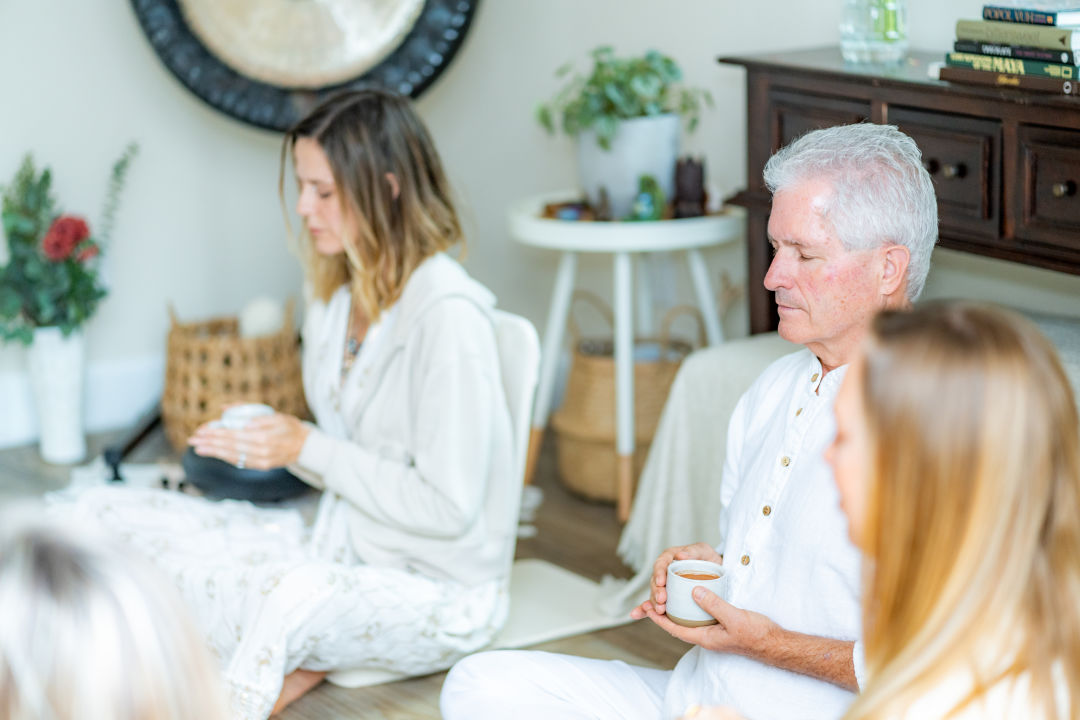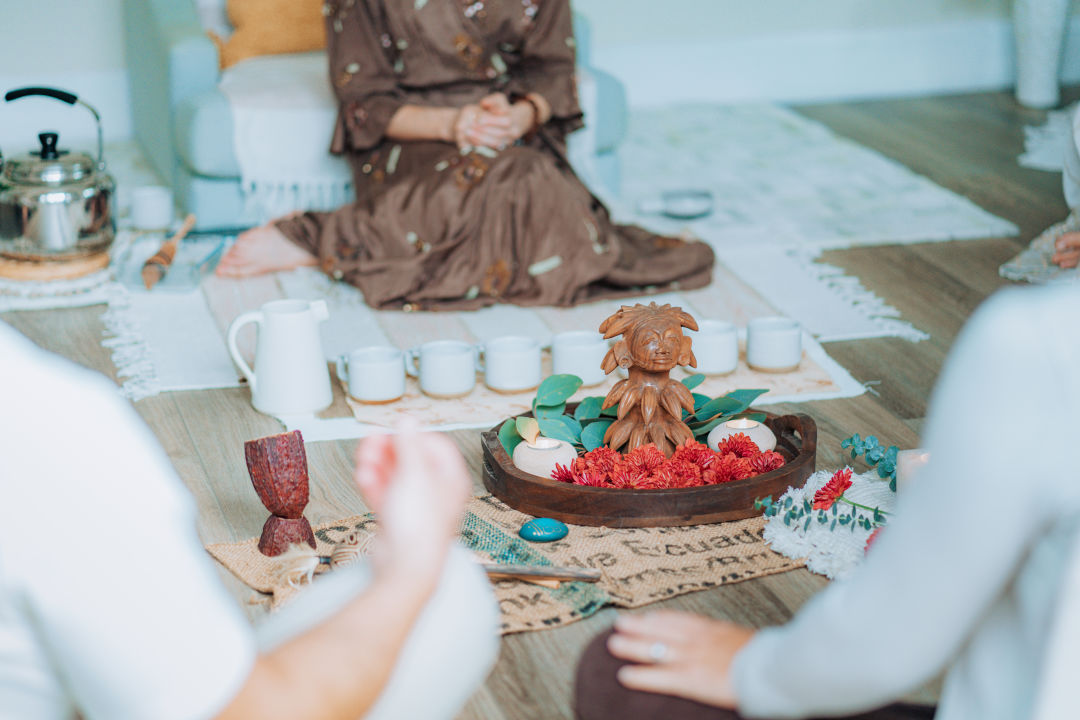
What It's Like to Attend a Ceremonial Cacao Circle
It’s easy to brush off a lot of New Age health practices as a bunch of monkey business—but the alternative health medicine industry will rake in more than $30 billion from the American public in a year. Self-proclaimed "healers" will gladly sell us copper shoes that are supposed to reconnect the human body to the earth’s electrons, brain tonics that claim you’ll become more alpha once you boost this neurotransmitter, and vaginal crystals that promise to prevent urinary incontinence and transmit unto the inserter the metaphysical property of the chosen gemstone. And we will buy them in the pursuit of feeling better.
I, too, want to feel better. But I'm also a cynic. I've tried red light therapies and energetic healings, but in the back of my mind, there’s always the suspicion that I'm just another sucker.
So when I was assigned to write a story about a local cacao and breathwork ceremony, my skeptical nature kicked in. I figured I’d just drink some bitter chocolate, take some deep breaths and then go back to my everyday life feeling pretty much the same.

Carrie Eckert
Image: Photography by Simo
When Carrie Eckert agreed to let me participate and write about her cacao and breathwork practice, she was also a little skeptical. She was concerned I might make fun of her practice. “I take cacao very seriously,” she said. I won’t deny that I have an occasional habit of teasing my subjects, but I promised her I would not be unkind and would only make fun of myself. We shook on it.
Eckert takes cacao so seriously because, she says, it healed her. For the better part of the last decade, Eckert says, she suffered from multiple, severe autoimmune conditions. Modern Western medicine couldn't explain or fix her suffering, so she experimented with her nutrition and holistic healing. But it wasn’t until she discovered cacao that she realized she had been living in a state of anxiety for most of her life.
“Cacao literally and figuratively opens the heart,” Eckert says. “After taking ceremonial cacao, my body felt so vastly different that it showed me that I didn’t need to live with that anxiety anymore.” She told me that she had always lived with a shell around her heart, and cacao cracked her wide open. Since then, she consumes about one ounce of high-grade cacao every day.

Eckert says the cacao she uses for her circles is sourced from communities that have reverence for each step in its production.
Image: Photography by Simo
First used by the Mayan and Aztec civilizations, cacao rituals have been around since 1500 BCE. Though it was primarily consumed as a source of food, over time it became prized as a potion and would only be available to the elite. But empires fell and the cacao plant prevailed and is now available at your local gas station (albeit in poor form). It’s unclear why cacao circles have become popular as of late. My guess would be that people who have tried magic mushroom or ayahuasca ceremonies are looking for something a little less intense.
The cacao circles Eckert leads are combined with breathwork—a practice of conscious, repetitive and sometimes intense breathing that can lead to altered states of consciousness. Eckert believes that combining breathwork with the heart-opening properties of cacao is the perfect pairing for real healing.
The circle I attended was held at Advanced Rejuvenation, an alternative health center in north Sarasota that provides nontraditional treatments like ketamine therapy, stem cell injections and cryotherapy. There were a dozen other participants, and each of us was given mats with pillows, a towel to cover our eyes and a blanket. We faced a smiling Eckert, who introduced herself and talked about the cacao we were about to drink. She told the story of her own healing and the Mayan astrological history of cacao.

During her cacao circles, Eckert tells the story of her own healing and the Mayan astrological history of cacao.
Image: Photography by Simo
Everything is political. Eckert acknowledged that she is a white woman practicing the tradition of a people she is not a part of, and while the chocolate trade has a lot of demons, she told us the cacao she uses for her circles is free from toxic heavy metals and was not harvested or made with child slave labor. “It is sourced from communities that have reverence for each step in its production,” Eckert said. “We do not want negative energy to go into what we are about to consume.” Our particular cacao was grown in Ecuador.
Eckert poured the cacao—a ceremonial dose of 1.5 ounces—into small bamboo cups. She told us to hold the chocolate close to our hearts and set an intention. “What do you want from this?” Eckert asked. I'm always at a loss in these moments. Usually, I want to know what it is I want, so I set that as my intention.

Participants set an intention before drinking the cacao.
Image: Photography by Simo
We drank the cacao. Eckert offered honey if we found the raw, untreated chocolate too bitter, but I liked it. It tasted like sweet earth. I felt its warmth drip down into my stomach like a shot of whiskey. Eckert told us more about the cacao. Ceremonial-grade cacao is particularly rich in micronutrients and antioxidants, but the magic compound that makes this chocolate special is called theobromine. Unlike the nervous system stimulation we get from caffeine, theobromine is a cardiovascular dilator. It widens the blood vessels and allows in more oxygen. That's what Eckert was referring to when she said cacao literally opens the heart.
After giving the cacao time to settle in our bodies, it was time for breathwork. We lay down on our mats and placed a hand towel over our eyes to block out the light. Eckert put on some generic Top 40 music to initiate the session and instructed us on how to breathe over the next half hour.

Ceremonial-grade cacao is particularly rich in micronutrients and antioxidants.
Image: Photography by Simo
“In through the stomach, then the chest, then out through your mouth,” she said. We began, and for the first minute, Eckert continued to remind us how to breathe, repeating “stomach, chest, out” like a hippie coxswain. Barely a few minutes in, I wondered how I could possibly continue to hyperventilate like this for a half hour while listening to music I disliked.
But then I felt a tingle in my fingers. The sensation grew into my hands and continued up my arms. Eckert continued to remind us to breathe. It felt like I was vibrating, like my hands were clenching and I couldn't release them, like I had grabbed hold of an electric fence and was unable to let go. Then I felt like my mouth was sealing itself closed. "What the hell is going on?!" I thought. A slight wave of panic entered my mind. "Is this supposed to happen?"
I slowed my breathing and the intensity waned. But I wanted it back, so I breathed faster and more deeply until it felt like my entire body was shaking. This wasn’t like doing psychedelics. I wasn’t falling into an endless pit of thoughts. It was the opposite—I was filling up my whole body. I could distinguish all my toes from one another. I could feel the individual hairs on my head. My hands clenched tighter.
Eckert turned the music down and told us to let out a sound. I let out a maniacal laugh. And then I started sobbing. I wasn’t sad, but the tears would not stop coming. I wasn’t thinking about anything in particular, but I hadn’t cried that hard in years, and I didn’t care that I was doing it in a room full of strangers.

After drinking the cacao, participants engage in breathwork.
Image: Photography by Simo
When the breathwork was over, Eckert gave us instructions on how to relax our bodies. I felt like I was still vibrating—like the old energy inside of me was evaporating. Then I blacked out for the next 20 minutes. I wasn't asleep, but I don't remember what happened until Eckert told us it was time to get up.
Sitting up, I knew that something had changed inside me. My body felt lighter and more open. I don’t know whether it was something in my blood or in my spirit that was different, but I didn't feel a single drop of the cynicism that I arrived with.